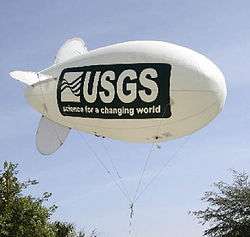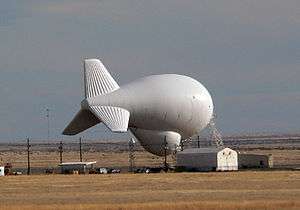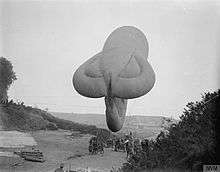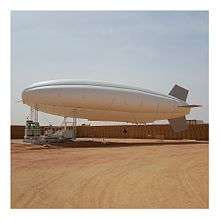Tethered balloon



| Look up aerostat in Wiktionary, the free dictionary. |

A tethered, moored or captive balloon is a balloon that is restrained by one or more tethers attached to the ground and so cannot float freely. The base of the tether is wound around the drum of a winch, which may be fixed or mounted on a vehicle, and which is used to raise and lower the balloon.
A balloon is a form of aerostat, along with the powered free-flying airship, although the American GAO has used the term "aerostat" to describe a tethered balloon in contrast to the airship.[1]
Tethered balloons have been used for a variety of purposes, including:
- Observation balloons
- Barrage balloons
- Advertising and other graphical displays
- Instrumentation or communications equipment platforms, for civil or military use
- Recreational flights
Design principles
Early balloons were simple round spheres, with a payload hung beneath. The round shape uses the minimum material to accommodate a given volume of lifting gas, making it the lightest construction. However in any significant wind the round shape is aerodynamically unstable and will bob about, risking damage or the balloon breaking free.
To avoid this problem the kite balloon was developed. This form has an elongated shape to reduce wind resistance and some form of tail surface to stabilise it so that it always points into the wind. Like the powered airship, such balloons are often called blimps.[2][3][4][5]
A hybrid tethered balloon or kytoon is shaped to provide aerodynamic lift similar to a kite, as well as to reduce drag.
History
Designed by Albert Caquot, French engineer, in 1914, the barrage balloons of World War I and World War II were early examples of tethered balloons. Military observation balloons were also used extensively in World War I. These early types used hydrogen as their lifting gas.
Today, tethered balloons are used for lifting cameras, radio antennas, electro-optical sensors, radio-relay equipment and advertising banners - often for long durations. Tethered balloons are also used for position marking and bird control work. Typically, they use the non-flammable gas helium to provide lift.
Modern use
Advertising
Tethered balloons are often used for advertising, either by lifting advertisement signs, or by using a balloon with advertisements written on, or attached to it. Often both methods are combined. It is not uncommon to use specially designed balloons. Blimp-shaped balloons are especially popular for advertising use. By suspending a light source within the envelope, the balloon can be illuminated at night, drawing attention to its message.
Balloon Soundings
During the project of the Preliminary Evaluation of Air Quality in Cyprus, a tethered balloon from the University of Stuttgart was used in Nicosia and Limassol, in 2003.The results concerning this part of the project are given in the report published in the Air Quality in Cyprus.
Civil aviation
The United States Geological Survey uses tethered balloons to carry equipment to places where conventional aircraft cannot go, such as above an erupting volcano. Tethered balloons are ideal as they can easily remain more or less in one place, are less likely to be damaged by volcanic ash, and are less expensive to operate than a helicopter.
Tethered balloons can be used as temporary transmitters, instead of a radio mast, either by using the tether which holds the balloon as the antenna, or by carrying antennas on the balloon fed by a fiber optic or radio frequency cable contained inside the tether. The advantage of tethered balloons is that great antenna heights are easily attainable and they can stay aloft for months.
Tethered balloons are also used as a recreational attraction and for joyrides.
Military and security aviation
During the 1990 Invasion of Kuwait, the first indication of the Iraqi ground advance was from a radar-equipped tethered balloon that detected Iraqi armor and air assets moving south.[6] Surveillance tethered balloons were used in the 2004 American occupation of Iraq. They utilized a high-tech optics system to detect and observe enemies from miles away. They have been used to over watch foot patrols and convoys in Baghdad, Afghanistan, and are permanently installed above US military bases in Kabul and Bagram.
The US Drug Enforcement Administration has contracted with Lockheed Martin to operate a series of radar-equipped tethered balloons to detect low-flying aircraft attempting to enter the United States. A total of twelve tethered balloons, called Tethered Aerostat Radar System, are positioned approximately 350 miles apart, from California to Florida to Puerto Rico, providing unbroken radar coverage along the entire southern border of the US.[7]
The U.S. Army has developed a tethered aerostat to perform operational testing at Aberdeen Proving Ground beginning in 2015. The system, called JLENS, uses two moored balloons designed to provide over-the-horizon missile defense capability.
See also
| Wikimedia Commons has media related to Tethered balloons. |
List of manufacturers
- Aerophile SA
- Aerostat based communications and surveillance
- Aero-Nautic Services & Engineering
- Air-Foil Aerostat
- ALTAVE
- Helikites
- Lindstrand Technologies
- Lockheed Martin PTDS Aerostat ISR system
- Raven Aerostar
- SkyDoc Aerostat resources
- TCOM
- Top I Vision
- Vigilance Rapid Deployable Aerostat
- Worldwide Aeros Corp
References
- ↑ "GAO-13-81, DEFENSE ACQUISITIONS: Future Aerostat and Airship Investment Decisions Drive Oversight and Coordination Needs" (PDF). Retrieved 2013-06-15.
- ↑ Wragg, D.; Historical Dictionary of Aviation, History Press, 2008, Pages 25-27: "Airship ... During the Second World War, the main combatants used barrage balloons, or blimps, to protect vital targets ...".
- ↑ Jonah Bromwich; Runaway Military Surveillance Blimp Drifts From Maryland to Pennsylvania, New York Times, 28 October 2015.
- ↑ South Korea Buys Israeli Radar System, CBN News, 17 February 2009.
- ↑ Tethered Blimps, Airship Solutions.
- ↑ "Persian Gulf States - Kuwait - Regional and National Security Considerations". Countrystudies.us. Retrieved 2013-06-15.
- ↑ "Tethered Aerostat Radar System - United States Nuclear Forces". Fas.org. Retrieved 2013-06-15.